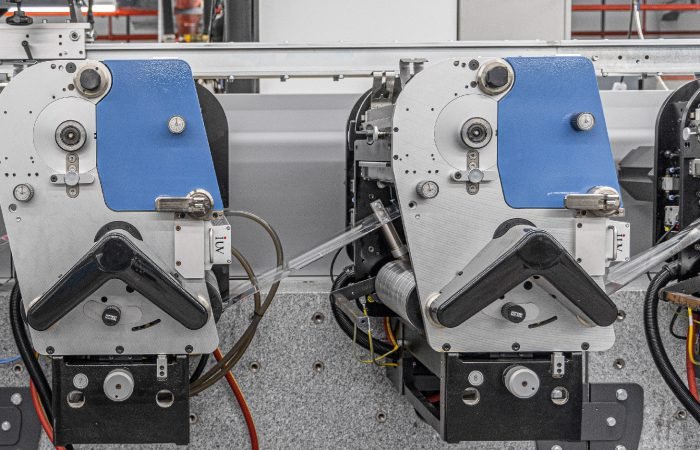Setting up UV curing systems in flexo printing involves several key factors. This guide will explore these critical elements, focusing on narrow web label printing and broader flexographic applications. We’ll delve into the specifics of UV curing technology, including LED UV, and how it impacts print quality and efficiency.
Understanding the substrate is paramount. Different materials absorb and reflect UV light differently. Paper, films, and foils all have unique properties that influence curing speed and effectiveness. For instance, highly absorbent substrates might require more intense UV energy to achieve full cure, while reflective surfaces could lead to backscatter, potentially affecting downstream processes. It’s vital to select UV lamps and configurations that match your specific substrate lineup. This ensures consistent ink adhesion and durability, crucial for high-quality label production.
Ink formulation is another cornerstone. UV inks contain photoinitiators that react to UV light, initiating the polymerization process that cures the ink. The type and concentration of these photoinitiators, along with the ink’s pigment load and viscosity, directly impact curing requirements. Some inks are designed for specific UV lamp wavelengths, particularly important when considering the move towards energy-efficient LED UV systems. Mismatched inks and lamps can lead to under-curing, resulting in poor rub resistance, smudging, and color shifts. Expert consultation with ink manufacturers is often beneficial to optimize this synergy.
The choice between traditional mercury vapor lamps and modern LED UV systems is a significant decision. Mercury lamps offer broad-spectrum UV output but consume more energy, generate more heat, and have a shorter lifespan. LED UV systems, on the other hand, are highly energy-efficient, have a much longer lifespan, emit less heat, and can be tailored to specific wavelengths. This wavelength specificity can lead to faster curing, lower energy costs, and improved print quality, especially for sensitive substrates. However, LED UV systems often have a higher initial investment cost. Evaluating your production volume, energy costs, and sustainability goals will guide this choice.
Lamp placement and intensity are critical for effective curing. In flexographic printing, UV lamps are typically positioned after each print station. The distance between the lamp and the substrate, as well as the lamp’s power output, directly influences the UV dose. Too little UV energy results in incomplete curing, while excessive energy can scorch the substrate or degrade the ink. Proper ventilation around the curing units is also essential to dissipate heat and prevent any buildup of ozone, a byproduct of some UV curing processes. Precise control over these parameters ensures consistent results across the entire print run.
Web speed plays an integral role in determining the required UV energy. Higher press speeds mean less dwell time under the UV lamp. To achieve a complete cure at faster speeds, the UV intensity must be increased accordingly. This often involves a careful balance between press speed capabilities and the power of the curing system. For narrow web label presses, where high speeds are common, selecting a robust UV system capable of delivering sufficient energy at production speeds is non-negotiable. Thorough testing at various speeds is recommended to establish optimal settings.
Cooling mechanisms are vital, especially when using powerful UV lamps. While LED UV systems generate less heat than mercury lamps, significant energy is still converted to heat. Inadequate cooling can lead to substrate warping, ink drying prematurely on the rollers, and potential damage to the printing press components. Many UV curing systems incorporate built-in cooling, but the overall design of the press and the surrounding environment can also influence heat management. Ensuring proper airflow and considering supplementary cooling if necessary contributes to system longevity and print quality.
Maintenance and cleaning are often overlooked but are crucial for sustained performance. Dust, ink residues, and debris on the UV lamps or reflectors can significantly reduce their effectiveness, leading to under-cured prints. Regular cleaning schedules, using appropriate cleaning agents, are essential. Lamp replacement, based on manufacturer recommendations or performance monitoring, also ensures that the system delivers consistent UV output. Proactive maintenance prevents costly downtime and maintains the high standards expected in label and flexible packaging printing.
Flexibility in system configuration is also a valuable consideration. The ability to adjust UV intensity, wavelength, and even turn individual lamps on or off provides greater control. This is particularly useful when printing a diverse range of jobs with different ink types and substrate requirements. Modular UV curing systems can offer this adaptability, allowing printers to optimize their setup for each specific application. This enhances the versatility of the printing press and broadens the scope of printable materials and finishes.
Safety protocols surrounding UV curing systems are non-negotiable. UV radiation can be harmful to eyes and skin. Proper guarding, interlocks, and warning signs are essential. Training for operators on safe handling and operation procedures ensures a secure working environment. Understanding the specific safety requirements for both mercury vapor and LED UV systems is crucial for compliance and the well-being of your team. This includes awareness of ozone generation from mercury lamps and the need for adequate ventilation.
Finally, consider the environmental impact and cost-effectiveness. LED UV systems offer significant advantages in energy savings and reduced waste due to their longer lifespan and lower heat output. While the initial investment might be higher, the long-term operational savings can be substantial. Evaluating the total cost of ownership, including energy consumption, lamp replacement costs, and potential improvements in print quality and throughput, is key to making an informed decision that benefits both your business and the environment.












